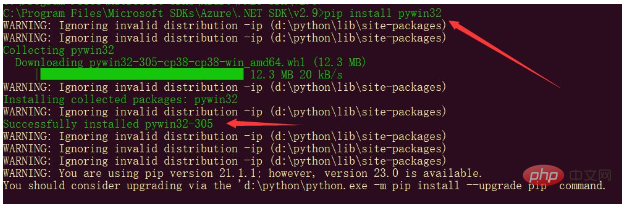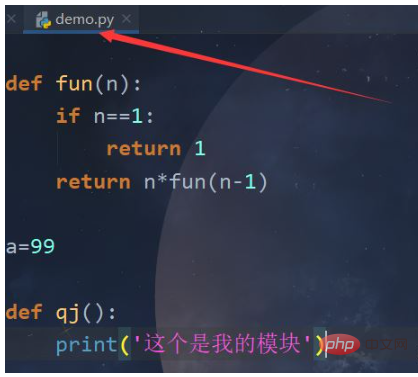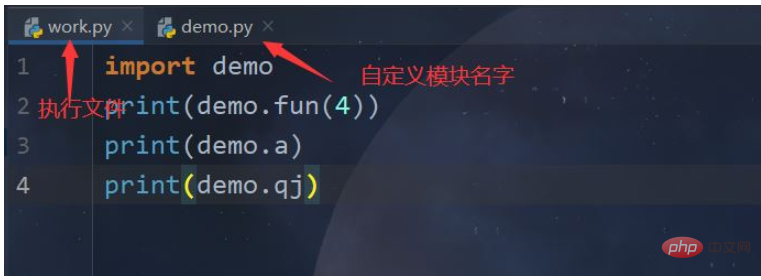What is a Python module and how to define and use it
1. What is a module
We learned about variable types (integer, string, list, tuple...etc.). Then I also learned about function types, which actually means combining some variables and then implementing some functions. In fact, modules are the same. A module combines functions, variables, etc. to form a Python file. The name of this file is also the name of the module. It can be said that the module is the essence of the Python code.
What is a module?
Module: It is a python file. When the python file is used as a module, the file name is the module name, demo.py( demo is the module name)Function: You can call the code and functions of other python files, which can be implemented and used more flexibly, and add various effects
How to use: We pass import (key words) to import the module
2. Classification of modules
Modules in Python are divided into three categories:
1. Built-in modules
2. Third-party modules
3. Custom modules
(1) Built-in module
Description:
Built-in module: The module that comes with Python after installing it can be used directly, such as time, os, re, random...
Note: When using it, you need to import
For example: import time
(2) Third-party modules
Instructions:
Third-party modules are not included in Python and need to be installed externally into Python. Yes, these modules are written by some big guys, we can install and use them, such as pygame, requests... etc.
For example:##Installation:
pip -- python's own downloaderinstall -- download
uninstall -- uninstallPrerequisite: pip does not set python environment variables If so, then this configuration cannot be found, so remember to configure the environment variables when downloading python. The default python download library is to use pip. If the python environment is not set up, pip cannot be used-->Repair/Reinstall
Suggestion: pycharm download module (first select cmd to download and then pycharm)
Method: Enter cmd, directly pip install module name

pip related instructions: #Download module(3 ) Custom modulepip install module name
#View modulepip list
#Uninstall modulepip uninstall module name
#Update pip Sometimes the version of pip is too low and the new library cannot be upgradedpython -m pip install --upgrade pip -i
# Accelerate through (cdn) proxy, download third-party modules:pip install library name --default-timeout=100 -i https://pypi.tuna.tsinghua.edu.cn/simple
pip install requests --default-timeout=100 -i https://pypi.tuna.tsinghua.edu.cn/simple
As the name suggests, it is a module that you make yourself and use it yourself. Of course, for us beginners, the modules we write ourselves are very common, and those third-party modules It is also written by individuals, but those people are big guys or some teams, and we still have to practice for another two and a half years.3. Use of modules
Import module:
import module name(import is Import meaning)
Use module:
import module nameModule name.Function name()
Single import
from module name import function name/variable nameFor example: from random import randint
Import all functions of this module
from module name import *Note: After importing, we can use these functions directly, just There is no need to use the module name.function name() method, just use the function name(). However, this method has a big disadvantage, that is, when we directly use the names of these functions or variables, It may conflict with the names of the variables or functions we define, resulting in overwriting. It is generally not recommended to use this method
Give the module an alias
If the module name is too long and difficult to remember, you can give it an alias through asimport module name as aliasWe can use the alias of this module directly later. , for example: import random as rr.random()4. Custom moduleWe can define a module ourselves and then execute the file Import it and use it directly, see the example:
This is a module I customized. I put this module file in the same directory as the executable file. When we want to use it, we can just import it directly.

def fun(n):
if n==1:
return 1
return n*fun(n-1)
a=99
def qj():
print('这个是我的模块')
Just import it very directly
5. Judgment of modules and executable files
The module is a py file and can be executed. When we import a module, the system has actually executed the module in advance and then executed the main file, but I want to make some of the module If this part is not executed, then I have to use a method to determine whether it is a module. If it is a module, then this part of the content will not be executed.
Method:
print(__name__) # If you run the code and the output is __main__, it means that this file is an executable file. If it returns a module name, it means that this is an executable file. The module is used
#模块代码
def fun(n):
if n==1:
return 1
return n*fun(n-1)
print(__name__)
a=99
def qj():
print('这个是我的模块')#执行文件的代码 import demo print(__name__) print(demo.fun(4))
Output result:

The demo is output first. This demo is actually the name of the module (you can see that the module It is executed first, and then the main file is executed), and __main__ means that this is an executable file, so we can use this method to determine whether a file is a module or an executable file.
For example:
#模块代码
def fun(n):
if n==1:
return 1
return n*fun(n-1)
if __name__=='__main__':
print(123456)When I call this module, 123456 will not be output, because this is a module.
The above is the detailed content of What is a Python module and how to define and use it. For more information, please follow other related articles on the PHP Chinese website!

Hot AI Tools

Undresser.AI Undress
AI-powered app for creating realistic nude photos

AI Clothes Remover
Online AI tool for removing clothes from photos.

Undress AI Tool
Undress images for free

Clothoff.io
AI clothes remover

AI Hentai Generator
Generate AI Hentai for free.

Hot Article

Hot Tools

Notepad++7.3.1
Easy-to-use and free code editor

SublimeText3 Chinese version
Chinese version, very easy to use

Zend Studio 13.0.1
Powerful PHP integrated development environment

Dreamweaver CS6
Visual web development tools

SublimeText3 Mac version
God-level code editing software (SublimeText3)

Hot Topics
 1377
1377
 52
52
 Do mysql need to pay
Apr 08, 2025 pm 05:36 PM
Do mysql need to pay
Apr 08, 2025 pm 05:36 PM
MySQL has a free community version and a paid enterprise version. The community version can be used and modified for free, but the support is limited and is suitable for applications with low stability requirements and strong technical capabilities. The Enterprise Edition provides comprehensive commercial support for applications that require a stable, reliable, high-performance database and willing to pay for support. Factors considered when choosing a version include application criticality, budgeting, and technical skills. There is no perfect option, only the most suitable option, and you need to choose carefully according to the specific situation.
 How to use mysql after installation
Apr 08, 2025 am 11:48 AM
How to use mysql after installation
Apr 08, 2025 am 11:48 AM
The article introduces the operation of MySQL database. First, you need to install a MySQL client, such as MySQLWorkbench or command line client. 1. Use the mysql-uroot-p command to connect to the server and log in with the root account password; 2. Use CREATEDATABASE to create a database, and USE select a database; 3. Use CREATETABLE to create a table, define fields and data types; 4. Use INSERTINTO to insert data, query data, update data by UPDATE, and delete data by DELETE. Only by mastering these steps, learning to deal with common problems and optimizing database performance can you use MySQL efficiently.
 MySQL can't be installed after downloading
Apr 08, 2025 am 11:24 AM
MySQL can't be installed after downloading
Apr 08, 2025 am 11:24 AM
The main reasons for MySQL installation failure are: 1. Permission issues, you need to run as an administrator or use the sudo command; 2. Dependencies are missing, and you need to install relevant development packages; 3. Port conflicts, you need to close the program that occupies port 3306 or modify the configuration file; 4. The installation package is corrupt, you need to download and verify the integrity; 5. The environment variable is incorrectly configured, and the environment variables must be correctly configured according to the operating system. Solve these problems and carefully check each step to successfully install MySQL.
 MySQL download file is damaged and cannot be installed. Repair solution
Apr 08, 2025 am 11:21 AM
MySQL download file is damaged and cannot be installed. Repair solution
Apr 08, 2025 am 11:21 AM
MySQL download file is corrupt, what should I do? Alas, if you download MySQL, you can encounter file corruption. It’s really not easy these days! This article will talk about how to solve this problem so that everyone can avoid detours. After reading it, you can not only repair the damaged MySQL installation package, but also have a deeper understanding of the download and installation process to avoid getting stuck in the future. Let’s first talk about why downloading files is damaged. There are many reasons for this. Network problems are the culprit. Interruption in the download process and instability in the network may lead to file corruption. There is also the problem with the download source itself. The server file itself is broken, and of course it is also broken when you download it. In addition, excessive "passionate" scanning of some antivirus software may also cause file corruption. Diagnostic problem: Determine if the file is really corrupt
 Does mysql need the internet
Apr 08, 2025 pm 02:18 PM
Does mysql need the internet
Apr 08, 2025 pm 02:18 PM
MySQL can run without network connections for basic data storage and management. However, network connection is required for interaction with other systems, remote access, or using advanced features such as replication and clustering. Additionally, security measures (such as firewalls), performance optimization (choose the right network connection), and data backup are critical to connecting to the Internet.
 How to optimize MySQL performance for high-load applications?
Apr 08, 2025 pm 06:03 PM
How to optimize MySQL performance for high-load applications?
Apr 08, 2025 pm 06:03 PM
MySQL database performance optimization guide In resource-intensive applications, MySQL database plays a crucial role and is responsible for managing massive transactions. However, as the scale of application expands, database performance bottlenecks often become a constraint. This article will explore a series of effective MySQL performance optimization strategies to ensure that your application remains efficient and responsive under high loads. We will combine actual cases to explain in-depth key technologies such as indexing, query optimization, database design and caching. 1. Database architecture design and optimized database architecture is the cornerstone of MySQL performance optimization. Here are some core principles: Selecting the right data type and selecting the smallest data type that meets the needs can not only save storage space, but also improve data processing speed.
 Solutions to the service that cannot be started after MySQL installation
Apr 08, 2025 am 11:18 AM
Solutions to the service that cannot be started after MySQL installation
Apr 08, 2025 am 11:18 AM
MySQL refused to start? Don’t panic, let’s check it out! Many friends found that the service could not be started after installing MySQL, and they were so anxious! Don’t worry, this article will take you to deal with it calmly and find out the mastermind behind it! After reading it, you can not only solve this problem, but also improve your understanding of MySQL services and your ideas for troubleshooting problems, and become a more powerful database administrator! The MySQL service failed to start, and there are many reasons, ranging from simple configuration errors to complex system problems. Let’s start with the most common aspects. Basic knowledge: A brief description of the service startup process MySQL service startup. Simply put, the operating system loads MySQL-related files and then starts the MySQL daemon. This involves configuration
 How to optimize database performance after mysql installation
Apr 08, 2025 am 11:36 AM
How to optimize database performance after mysql installation
Apr 08, 2025 am 11:36 AM
MySQL performance optimization needs to start from three aspects: installation configuration, indexing and query optimization, monitoring and tuning. 1. After installation, you need to adjust the my.cnf file according to the server configuration, such as the innodb_buffer_pool_size parameter, and close query_cache_size; 2. Create a suitable index to avoid excessive indexes, and optimize query statements, such as using the EXPLAIN command to analyze the execution plan; 3. Use MySQL's own monitoring tool (SHOWPROCESSLIST, SHOWSTATUS) to monitor the database health, and regularly back up and organize the database. Only by continuously optimizing these steps can the performance of MySQL database be improved.




